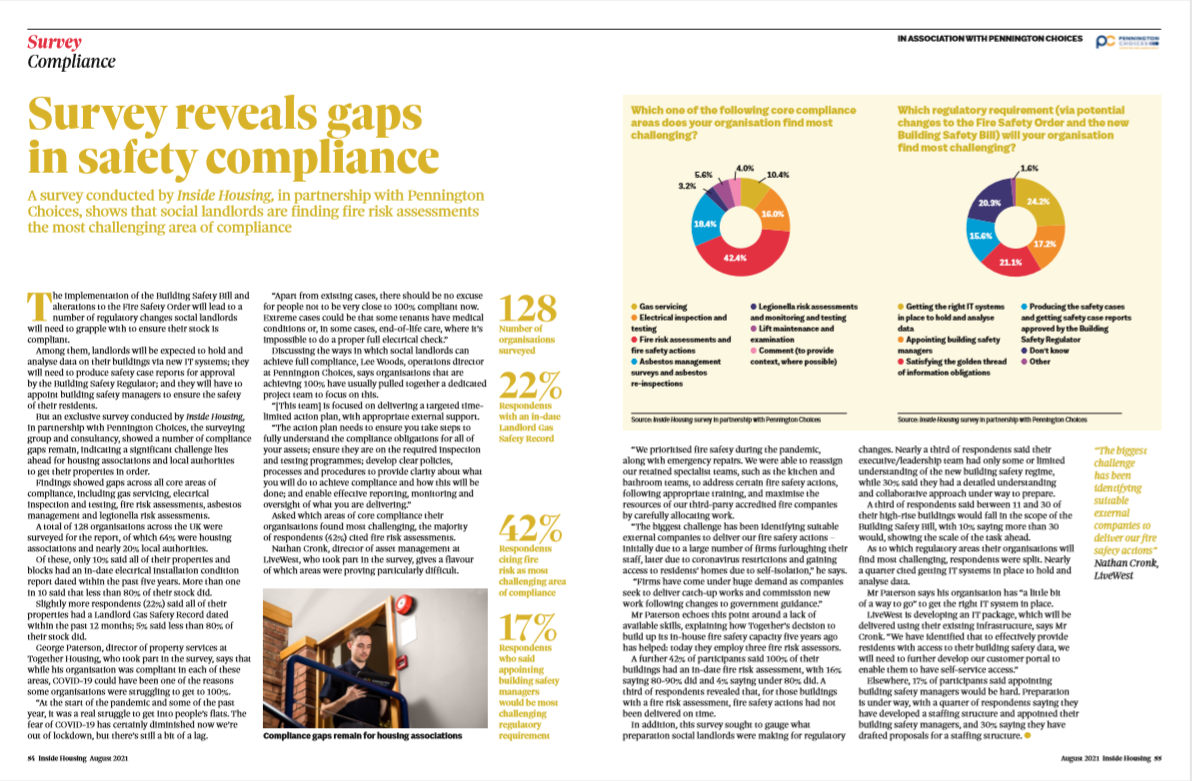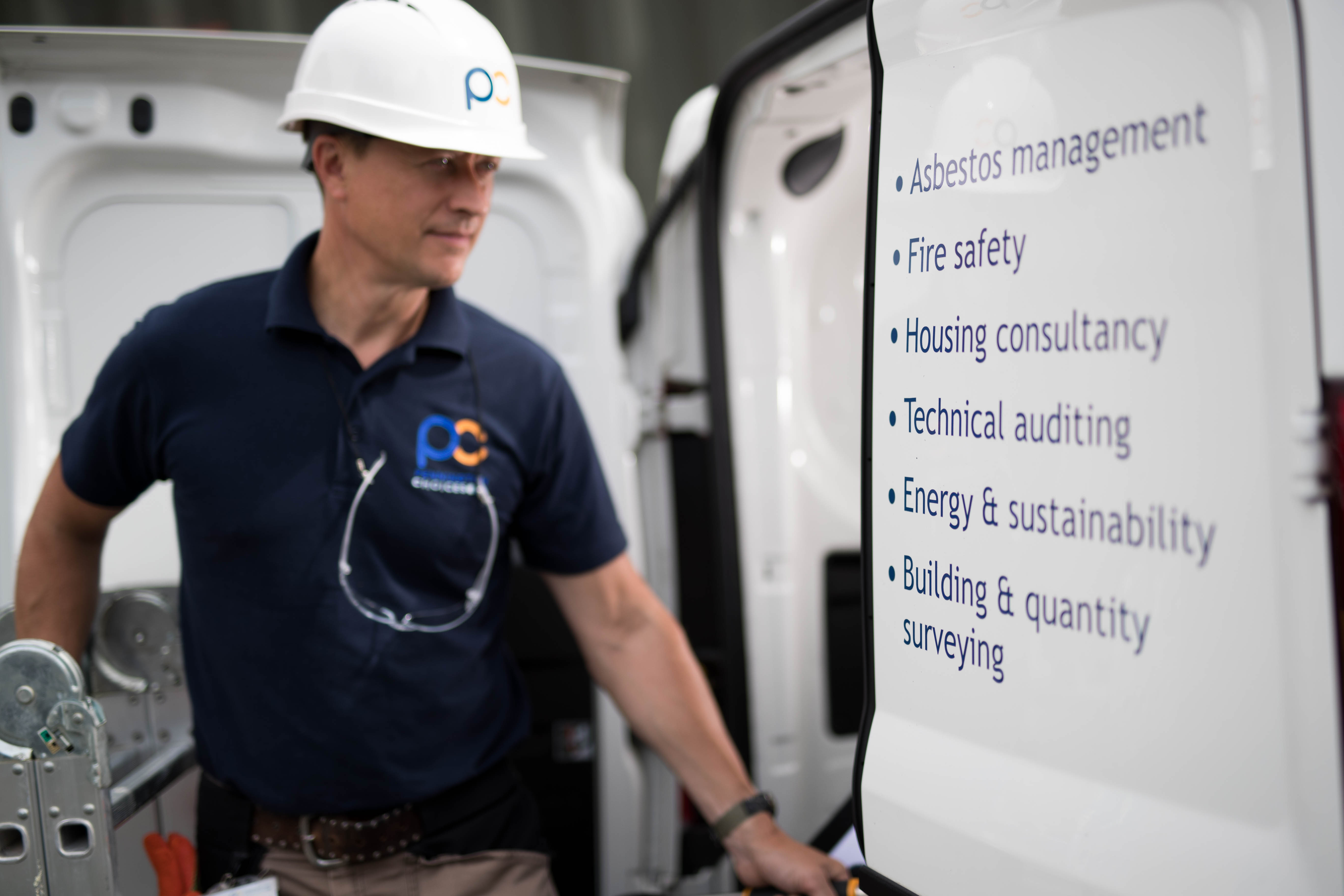Sign up to our newsletter
5 key takeaways you need to know to help keep people safe
Effective fire prevention starts with properly understanding the risks. The management of fire risk is a crucial concern for anyone in charge of a single building or a collection of buildings.
The Fire Safety Act 2021 (“The Act”) was introduced and passed through the parliamentary process in April 2021 to ensure that people feel safe in their homes and a tragedy like Grenfell, where 72 people lost their lives, never happens again. The date has not yet been confirmed when the Act comes into force, but it is expected to be at the beginning of 2022. Whether you own, manage, or operate an organisation, you need to comply with fire safety law.
The Act, which only applies in England and Wales revises the Regulatory Reform (Fire Safety) Order 2005 (RRO) and clarifies responsibility for managing and reducing fire risk in multi-occupied residential buildings. The onus to ensure updated guidance is followed, is firmly placed on the ‘Responsible Person’. A responsible person may include building owners, leaseholders, or managers.
Read our blog here for more details about the responsibility of a Responsible Person.
Of key importance is the amendment to the RRO, making it clear the legislation will apply to the structure and external walls and any common parts (as well as all doors between the domestic premises and common parts) of any building containing two or more sets of domestic premises. The reference to external wall includes doors and windows in those walls as well as anything attached to the exterior of the walls, including cladding and balconies.
The Fire Safety Act 2021 will complement the upcoming Building Safety Act 2022, an act designed to overhaul regulations, altering how buildings should be designed, constructed, controlled, and maintained to ensure they are safe to use. The Building Safety Act 2022 aims to put residents at the heart of a new system of Building Safety and improve the competence of the people responsible for overseeing, managing, and delivering the building works.
The consequences of being unsure of compliance responsibilities can be severe yet some organisations remain uncertain of the responsibilities that legislation, including the Fire Safety Act places upon them. A survey with Inside Housing in 2021 highlighted how 42% of people surveyed found fire safety the most challenging area of compliance, in terms of both the fire risk assessment process and the management and delivery of fire safety actions. 60% of those landlords did not have fully compliant fire risk assessments in place and of those, 40% were not delivering their fire safety actions on time and in accordance with what a fire risk assessor had set out. There are serious gaps in provision, and it is clear there is further work the sector needs to do. 
Read the full survey results here.
The Fire Safety Act has been introduced to tackle the widespread complacency around fire safety in general. Read on to find out everything you need to know about The Act and its impact upon you.
Fire Safety Act – 5 key takeaways you need to be aware of:
1. The Act applies to multi-occupied, residential buildings only and is not dependent on the height of a building. Where a building contains two or more sets of domestic premises, the areas to which the Fire Safety Order applies include the building’s structure and the exterior walls and anything attached to them, such as:
- doors
- windows
- balconies
- cladding
- insulation
- other fixings
- and any common parts
Click here for our comprehensive list of all fire related key terms.
3. The Act empowers the government to issue risk-based guidance which can be referred to as evidence that a 'Responsible Person' has either fulfilled or failed to fulfil the conditions of the Act. Under the Fire Safety Act, building owners will be held to account for any failings in compliance. There are also proposals to increase the level of fines for certain offences, including the failure to comply with specific requirements imposed by an inspector.
4. The Fire Safety Act 2021 makes it far easier for Fire Services to prosecute/and or fine the Responsible Person if the necessary fire risk assessments have not been carried out. Carrying out the actions recommended within your Fire Risk Assessments will offer the best defence to ensure you are doing everything possible to protect people from fire.
5. A Responsible Person must commission a Fire Risk Assessment (FRA) to assess the structure and external walls including attachments such as balconies, cladding, fixes, and insulation. An FRA will help to identify areas where a fire might start. All Responsible Persons are required to record their fire risk assessments and fire safety arrangements, making recommendations to reduce the likelihood of fire and to keep people safe should a fire occur. A Fire Risk Assessment must be a dynamic document and always kept up to date.
.png?width=770&name=ezgif-com-gif-maker%20(12).png)
What is a Fire Risk Assessment (FRA)?
If you are responsible for a building, it is important you do all you can to reduce the risk of fire to keep people safe. It is a legal duty, and it saves lives.
A Fire Risk Assessment reviews premises to identify any areas where a fire might start. It makes recommendations to lower the possibility of fire and keep people safe when a fire occurs. Importantly, it identifies the fire safety measures required to make the premises safe for employees or residents, as well as other ‘relevant people’. A Fire Risk Assessment enables you to ensure you are doing everything practically possible and demonstrate it. It includes an evaluation of Passive Fire Protection which plays a vital role in safeguarding people and is an essential component of any fire safety strategy. Passive Fire Protection is built into the structure of a building to safeguard people's lives and limit the financial impact of damage to buildings and their contents.
A Fire Risk Assessments comprehensively cover the following points to meet statutory obligations:
- Means of escape
- Fire detection and warning systems
- Firefighting equipment
- Removal or safe storage of dangerous substances
- The needs of vulnerable people (elderly, young children, or those with disabilities, etc.)
- Other fire safety features (passive and active fire protection)
- Compartmentation
- Cladding
- Evacuation strategies
- Detailed action plan
- Asset register (on request)
How to carry out a Fire Risk Assessment – a fire safety checklist.
A Fire Risk Assessment will help to establish the likelihood of a fire starting and the hazards from fire that the premises present for the people using the building or those in the surrounding area. The primary aim should always be to remove those hazards. Where this is not possible, it is essential to reduce them and implement additional control measures.
Fire Risk Assessments are conducted in five key steps:
1. Identify people at riskEveryone is at risk if there is a fire. It is also important to consider whether the danger is greater for some than others, for example people who work at night or those unfamiliar with the buildings such as visitors or customer. Children, the elderly or disabled people are especially vulnerable.
2. Identify any potential fire hazards.
Fire starts when heat (source of ignition) comes into contact with fuel (anything that burns), and oxygen (air). You need to keep sources of ignition and fuel apart.
Do you have adequate fire safety measures in place? Do staff have the necessary fire safety training? Have you taken any action to minimise sources that may fuel a fire? Are fire drills carried out regularly, do staff know about escape routes and where they are? Are staff aware of what is expected from them with regards to reducing the risk from fire, and how to respond if a fire breaks out?
4. Record your findingsHave you recorded the significant findings of your assessment? Are your records available for your occupants and the relevant enforcing authority?
5. Review and reviseIf there are significant changes in your buildings, has your FRA been reviewed and updated to reflect these changes? Have the relevant people been notified? Considering the changes, is re-training needed?
For more information, download our free Landlords Guide to Fire Risk Assessments and Fire Door Audits, click here.
.png?width=770&name=ezgif-com-gif-maker%20(13).png)
Why should you have an independent audit of your FRAs?
If you already have a Fire Risk Assessment in place but you want to ensure you are doing everything you can to keep your tenants and building safe, having an independent audit of your Fire Risk Assessments will help.
A fire safety consultant will be able to carry out an independent audit of your Fire Risk Assessment to help you keep people safe, raise the standards of your existing FRA suppliers and also to assure your tenants and board that you are meeting the expectation of the regulator. Audits can help provide clearly defined metrics and actions your FRA suppliers may need to take to keep people and buildings safe. To avoid compliance scrutiny, intervention, or downgrade, an independent audit can help you demonstrate practical compliance.
For details about our new Technical Auditing service, click here.
Questions to now ask:
- Do you know the difference between Passive and Active Fire protection? Do you have a Fire Risk Assessment in place for all buildings, which includes an assessment of the external walls, including cladding, balconies, and windows? Do you know how to carry out a Fire Risk Assessment and is an FRA enough to keep your people and buildings safe?
- Are the Fire Doors in your building regularly maintained and do they have the appropriate intumescent and fire-rated hardware?
- Has a 'Responsible Person' been appointed and do they understand the implications of not complying with the fire safety order 2005 and new fire safety act 2021?
- Is the 'Responsible Person' keeping up-to-date records of their fire risk assessments, fire safety arrangements and completing the actions required following the fire risk assessments?






